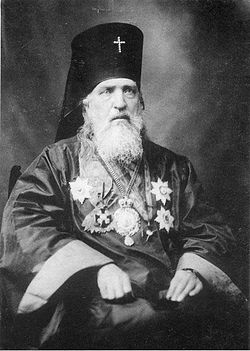Top Qs
Timeline
Chat
Perspective
February 16 (Eastern Orthodox liturgics)
From Wikipedia, the free encyclopedia
Remove ads
February 15 - Eastern Orthodox liturgical calendar - February 17

All fixed commemorations below are observed on March 1 (February 29 on leap years) by Eastern Orthodox Churches on the Old Calendar.[note 1]
For February 16th, Orthodox Churches on the Old Calendar commemorate the Saints listed on February 3.
Saints
- Hieromartyrs Pamphilus of Caesarea, Priest, and 11 companions, at Caesarea in Palaestina (c. 307-309):[1][2][3][4][5][note 2]
- Valens, Deacon, and Martyrs Paul, Seleucus, Porphyrius, Julian, Theodulus, Elias, Jeremiah, Isaiah, Samuel, and Daniel.
- Saint Maruthas of Martyropolis, Bishop of Sophene and Martyropolis (422), and the Martyrs of Persia (4th century), whose relics rest in Martyropolis.[1][3][7][8]
- Saint Flavian I of Antioch, Archbishop of Antioch (404)[9][10] (see also: September 27)
- Saint Flavian the Confessor, Archbishop of Constantinople (449)[1][3][11]
- Venerable Flavian the Hermit, monastic and Wonderworker.[3][12][note 3]
- Saint Mary the New, of Byzia in Thrace (9th century)[1][10]
Remove ads
Pre-Schism Western saints
- Saint Onesimus, of the Seventy Apostles (c. 68)[13][14][note 4][note 5] (see also: February 15)
- Saint Honestus (Honestus of Nîmes), a disciple of Saturninus of Toulouse, who preached the Gospel in Spain (270)[13][15]
- Saint Faustinus of Brescia, Bishop of Brescia and Confessor (381)[6][13][note 6]
- Hieromartyr Tanco of Verden, Bishop of Verden (815)[16][17][18][19]
Post-Schism Orthodox saints
- New Monk-martyr Romanus of Karpenision and Kapsokalyvia, Mount Athos, at Constantinople (1694)[1][10][20] (see also January 5)
- Saint Basil Gryaznov of Pavlovo-Posadsky (1869)[1][10]
- Saint Macarius (Nevsky), Metropolitan of Moscow, Apostle to the Altai (1926)[1][10]
- Saint Nicholas of Japan, Archbishop and Equal-to-the-Apostles (1912)[21] (New Calendar date see also: February 3)
New martyrs and confessors
Other commemorations
- Translation of the relics of Virgin-martyr Juliana of Nicomedia (304)[note 7] (see also December 21)
- Synaxis of the 'Cypriot' Icon of the Theotokos.[23][24]
Icon gallery
- St. Maruthas of Martyropolis, Bp. of Sophene and Martyropolis
- St. Flavian the Confessor, Abp. of Constantinople.
- Martyrdom of St. Onesimus.
- St. Nicholas of Japan.
- Virgin-martyr Juliana of Nicomedia.
Notes
- The notation Old Style or (OS) is sometimes used to indicate a date in the Julian Calendar (which is used by churches on the "Old Calendar").
The notation New Style or (NS), indicates a date in the Revised Julian calendar (which is used by churches on the "New Calendar"). - "At Caesarea, in Palestine, the holy martyrs Elias, Jeremias, Isaias, Samuel, and Daniel, Egyptians, who of their own accord served the confessors of Christ condemned to labor in the mines of Cilicia, but were arrested on their return, and after being cruelly tortured by the governor Firmilian, under the emperor Galerius Maximian, were put to the sword. After them, St. Porphyry, servant of the martyr Pamphilus, and St. Seleucus, a Cappadocian, who had been victorious in several combats, being again exposed to torments, won the crown of martyrdom, the one by fire, the other by the sword."[6]
- Venerable Flavian followed the monastic state and that of asceticism from a young age. It is said that he went to the top of a mountain and spent sixty and some odd years there in fasting and prayer. God blessed him as a Wonderworker and he reposed in peace.
- The slave who ran away from his master Philemon, was converted by St Paul in Rome and was the occasion of the Apostle's letter to Philemon.
- "THE birthday of blessed Onesimus, concerning whom the apostle St. Paul wrote to Philemon. He made him bishop of Ephesus after St. Timothy, and committed to him the office of preaching. Being led a prisoner to Kome, and stoned to death for the faith of Christ, he was buried in that city; but his body was afterwards carried to the place where he had been bishop."[6]
- The successor of St. Ursicinus about the year 360, as Bishop of Brescia in Italy. He was a descendant of Sts. Faustinus and Jovita and compiled their Acts.
- "At Cumae, in Campania, the Translation of St. Juliana, virgin and martyr. Under the emperor Maximian, she was first severely scourged by her own father, Africanus, then made to suffer many torments by the prefect, Evilasius, whom she had refused to marry. Later being thrown into prison, she encountered the evil spirit in a visible manner. Finally, as a fiery furnace and a caldron of boiling oil could do her no injury, she terminated her martyrdom by decapitation."[6]
Remove ads
References
Sources
Wikiwand - on
Seamless Wikipedia browsing. On steroids.
Remove ads







